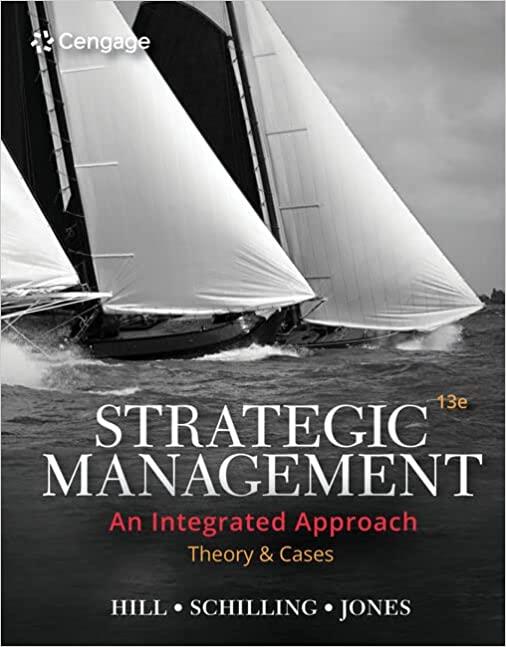In 1979, JCB, the large British manufacturer of construction equipment, entered into a joint venture with Escorts,
Question:
In 1979, JCB, the large British manufacturer of construction equipment, entered into a joint venture with Escorts, an Indian engineering conglomerate, to manufacture backhoe loaders for sale in India. Escorts held a majority 60% stake in the venture, and JCB held 40%. The joint venture was a first for JCB, which historically had exported as much as two-thirds of its production from Britain to a wide range of nations.
However, high tariff barriers made direct exports to India difficult.
JCB would probably have preferred to go it alone in India, but government regulations at the time required foreign investors to create joint ventures with local companies. JCB believed the Indian construction market was ripe for growth and could become very large. The company’s managers believed that it was better to get a foothold in the nation, thereby gaining an advantage over global competitors, rather than wait until the growth potential was realized.
Twenty years later, the joint venture was selling some 2,000 backhoes in India and had an 80% share of the Indian market for that product. After years of deregulation, the Indian economy was booming.
However, JCB felt that the joint venture limited its ability to expand. For one thing, much of JCB’s global success was based upon the utilization of leadingedge manufacturing technologies and relentless product innovation, but the company was very hesitant about transferring this knowhow to a venture where it did not have a majority stake and therefore lacked control. The last thing JCB wanted was for these valuable technologies to leak out of the joint venture into Escorts, which was one of the largest manufacturers of tractors in India and might conceivably become a direct competitor in the future. Moreover, JCB was unwilling to make the investment in India required to take the joint venture to the next level unless it could capture more long-run returns.
In 1999, JCB took advantages of changes in government regulations to renegotiate the terms of the venture with Escorts, purchasing 20% of its partner’s equity to give JCB majority control. In 2002, JCB took this to its logical end when it responded to further relaxation of government regulations on foreign investment to purchase all of Escorts’ remaining equity, transforming the joint venture into a whollyowned subsidiary. Around the same time, JCB also invested in wholly-owned factories in the United States and Brazil.
In early 2005, having gained full control, JCB increased its investment in India, announcing it would build a second factory that would serve the fast-growing Indian market. At the same time, JCB announced it would set up another wholly-owned factory in China to serve that market. India and China, the two most populous nations in the world, were growing rapidly; construction was booming; and JCB, then the world’s fifth-largest manufacturer of construction equipment, was eager to expand its presence to match its global rivals, particularly Caterpillar, Komatsu, and Volvo, which were also expanding aggressively in these markets.
By 2008, JCB’s foreign investment was bearing fruit. The product line had been expanded from 120 machines in 2001 to over 250. JCB had 47 dealers and some 275 outlets around India, and it claimed a market share in India of 53%. Over the next few years, JCB continued to gain business in India. By 2016, it was the market leader for construction equipment in India, with a 66% share and a network of 60 dealers and 600 outlets. In 2016, boosted by strong demand growth due to heavy infrastructure investment in India, JCB opened two new factories in the country, increasing its local workforce to 5,000. By 2018, it was generating £2.62 billion in annual sales, over £1.4 billion of which came from India. In addition to strong demand in India, JCB’s Indian factories were also now exporting to 93 other countries. India had become the jewel in the crown for JCB.
Questions
1. What was the strategic rationale underlying JCB’s entry into India in 1979, and into China in 2005? Given that capital to fund expansion is limited, does it make more sense for JCB to expand its presence in these markets, as opposed to more developed markets such as those of Western Europe?
2. Why do you think JCB chose to enter India via a joint venture, as opposed to some other entry mode?
3. Why did JCB not simply license its technology to Escorts?
4. What were the potential disadvantages of JCB’s joint venture with Escorts?
5. What were the benefits of gaining full control of the Indian joint venture in 2002? Can you think of any drawbacks?
6. Why do you think JCB has been so successful in India?
Step by Step Answer:

Strategic Management Theory And Cases An Integrated Approach
ISBN: 9780357033845
13th Edition
Authors: Charles W. L. Hill, Melissa A. Schilling, Gareth R. Jones





